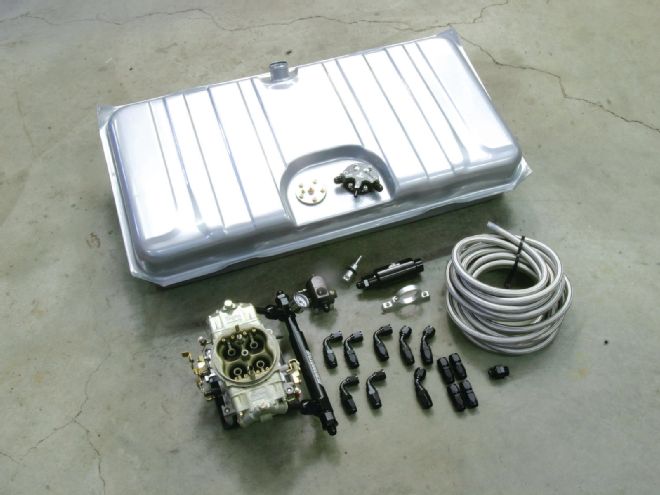
You've heard it before: Horsepower is stupid-easy to make these days. But in order to make big-time power, you must have two things: air and fuel. The air part is easy—it's there for the taking. Fuel has to be delivered; the days of a simple mechanical fuel pump working like an old-time, hand-operated water pump on your grandfather's farm are long gone. Today, if you want to make 500 to 800—or even a 1,000 hp—you must have a fuel- delivery system that can deliver, especially if the engine is fuel injected. But this doesn't mean the system has to be complex or include a pump the size of Cleveland. Aeromotive has just released a new Stealth fuel-tank assembly for early Camaros that offers the best of both worlds—a system that can deliver enough fuel to satisfy the hungriest power-adder street motor yet is ridiculously simple in design and execution.
The heart of Aeromotive's new system is the company's new Stealth 340 pump. At first glance, it doesn't appear that this little turbine-style pump could possibly be stout enough to feed a normally aspirated, 1,000hp carbureted engine, but that's exactly what it can do. The peak horsepower levels change when we talk about EFI or supercharged EFI because of the higher fuel pressures, but this pump is still plenty impressive. Basically, as fuel-pressure demands increase (as with EFI), volume decreases slightly, but we're still talking about delivering sufficient fuel to feed an 850hp normally aspirated EFI engine and 700 hp if that EFI engine is boosted. When you consider this pump is barely 5 inches in length and 11⁄2 inches in diameter, that's an awful lot of performance from such a small package.
Beyond the pump, Aeromotive has developed a new fuel tank for older muscle cars, allowing the company to create a similar design for OE applications that has been called "pump on a stick." This involves a fuel pump attached directly to an assembly that drops into the tank through an access hole. The key to making any high-pressure pump perform properly in an EFI environment is ensuring there is sufficient fuel around the pickup at all times. This requires a baffling system that the Stealth tank incorporates into the area surrounding the pump that allows it to continue to deliver solid fuel pressure even when the tank is nearly empty. This is critical for fuel-injected engines because if the pump's inlet is exposed to air instead of fuel (due to sloshing), the fuel pressure immediately drops, and the engine experiences a lean surge. Under full load, this can create a dangerous lean condition that could cause severe engine damage. Carbureted engines avoid this situation since they employ a fuel reservoir in the float bowl that can accommodate temporary fluctuations in fuel pressure. EFI engines don't have that luxury. While there are numerous aftermarket solutions to this problem, the simplest is to incorporate a baffle or reservoir system around the fuel-pump pickup.
The Aeromotive system has incorporated all these features into a replacement, 18-gallon, steel fuel tank that offers a large, drop-in pump and reservoir system that still fits within the confines of the stock tank's envelope. The sending unit consists of the pump, the pickup, the reservoir, a -6 pressure outlet, a -6 return-line fitting, and a -6 vent-line opening. This is all nicely recessed into the top of the tank so that it still fits flush with the floor. Aeromotive's first application is for the ubiquitous 1967–1969 Camaro, but other applications for such models as the 1955–1957 Chevy, 1964–1968 Mustang, second-gen Camaro, and 1964–1967 Chevelle are now on their way.
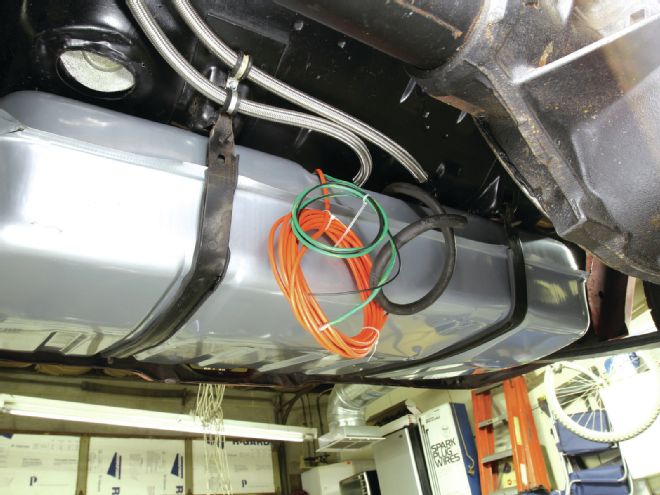
1. Here is the Aeromotive tank installed in our 1967 Camaro. The powdercoated tank is the same depth as stock, which means it does not hang down like other aftermarket tanks. Capacity is 18 gallons.
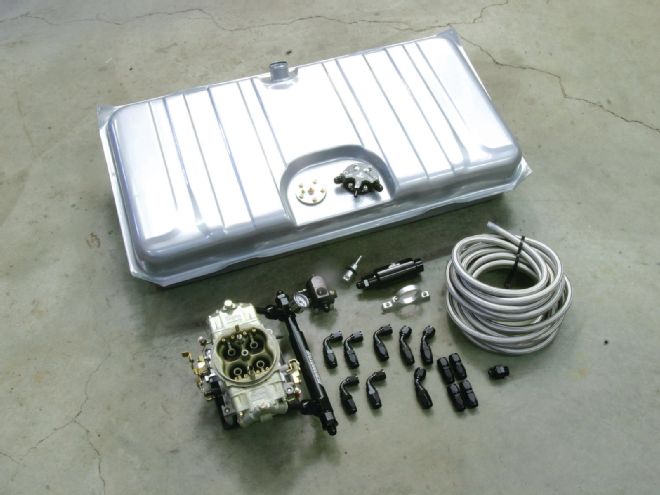
2. This is the Aeromotive tank assembly complete with an external fuel filter, fittings, and a carbureted fuel log for our early Camaro. Aeromotive also includes a separate 90-ohm fuel-level sending unit that is compatible with stock fuel gauges.
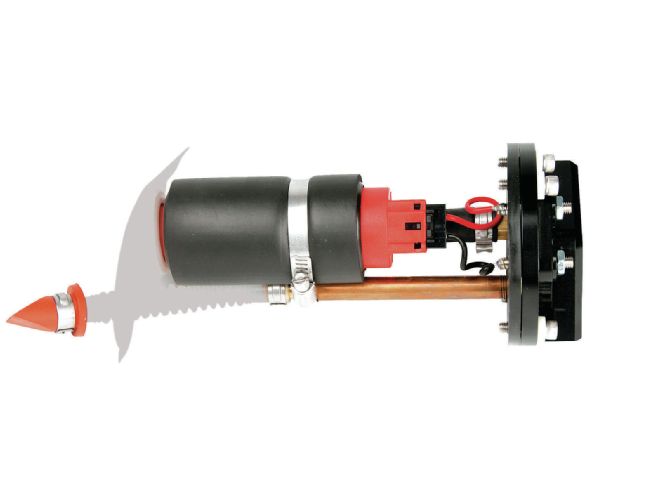
3. This is a tight view of the pump assembly removed from the tank. Note the integrated filter on the inlet side and the flexible return with an attenuator (Aeromotive calls it a duck bill!) on the end to reduce fuel aeration as the fuel re-enters the tank.
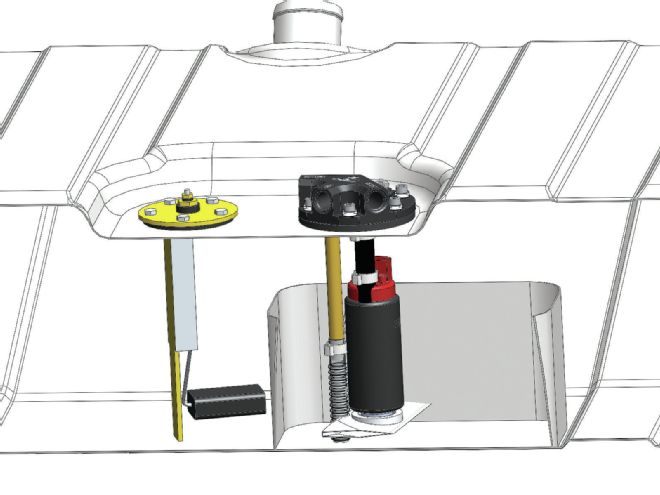
4. This Aeromotive drawing shows how the pump assembly integrates with the tank's internal baffling. This is crucial for any EFI application.
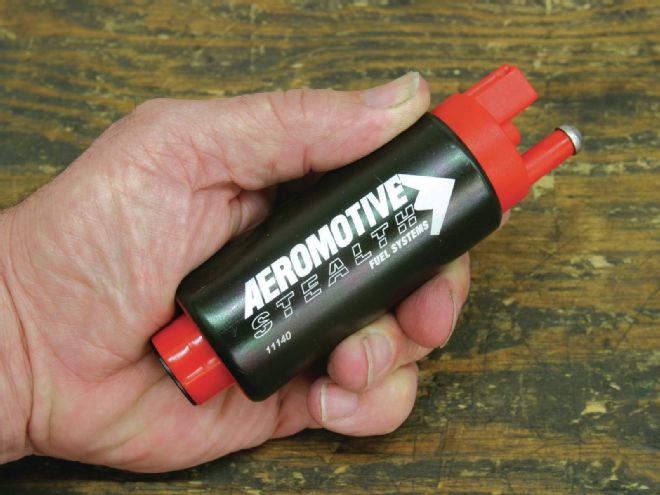
5. Don't let the Stealth 340's small size fool you. At 45 psi of EFI fuel pressure, this pump can produce enough volume to easily feed 700-plus normally aspirated horsepower. At 45 psi, the pump pulls about 14 amps, and as pressure increases, the amperage draws up to around 18 amps at 90 psi. This is sufficient current draw to demand a high-quality relay and circuit breaker.
Aeromotive has designed this system to be purchased as just the tank and pump-assembly alone or to outfit an entire fuel-delivery system, with components such as fuel filters, regulators, fuel fittings, and even one of Aeromotive's trick carburetor fuel logs. This is what we decided to install on our 1967 Camaro buildup, complete with an all-aluminum, carbureted, 400hp 5.3LS engine. The beauty of this system is that while our initial induction package will be carbureted, if we decide later to install EFI, the only change we have to make is to jack the fuel pressure with a different regulator. The rest of the system will remain intact. We could even add a Roots or centrifugal blower if we so desired, as long as the fuel pressure was boost-referenced. The Stealth 340 pump has the capacity to handle up to 700 hp for a boosted EFI application. That's pretty stout for a fuel pump that will fit in the palm of your hand.
We've outlined the parts and installation on our Camaro to show you just how easy it is to install and use. Over the years, we've installed a ton of different fuel-delivery systems in various cars. This has to be one of the simplest and easiest to install that also offers a wide array of coverage.
PARTS LIST Description PN Source Price Aero tank assembly 1967 18657 Summit Racing 739.95 Aero tank assembly 1969 18658 Summit Racing 739.95 Aero fuel filter 12321 Summit Racing 99.95 Aero filter bracket 12305 Summit Racing 67.95 Aero carb regulator 13207 Summit Racing 213.95 Aero pressure gauge 15632 Summit Racing 29.95 Aero carb fuel log 14201 Summit Racing 285.95 Aero -6 ORB plug 15626 Summit Racing 9.25 Aero -10 ORB /-8 15610 Summit Racing 15.95 Aero -8 ORB /-8 AN 15607 Summit Racing 13.95 Aero -8 ORB/-6 AN 15649 Summit Racing 17.95 Aero -6 AN to 5⁄16 inch 15635 Summit Racing 21.95 Aero -8 90 hose end 15655 Summit Racing 39.95 Aero -8 hose end 15653 Summit Racing 22.95 Aero wiring kit 16301 Summit Racing 77.95 Stealth 340 pump 11140 Summit Racing 175.95
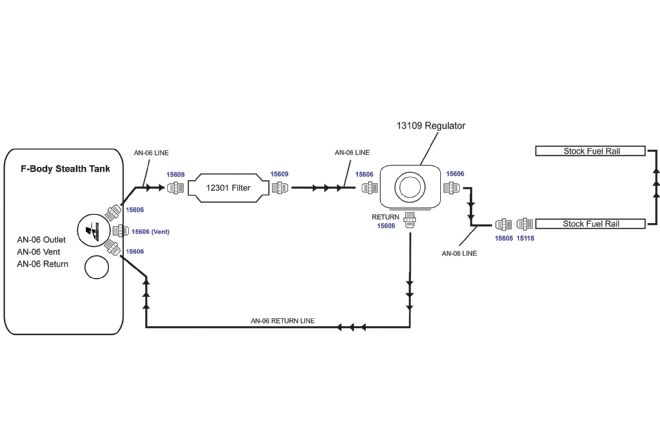
6. Tim Moore installed the Stealth tank in our Camaro, modifying Aeromotive's aluminum fuel filter mount to adapt it to the stock Camaro subframe. The fittings in and out of the Aeromotive filter are -8 Aeromotive O-ring (ORB, O-ring boss) fittings.
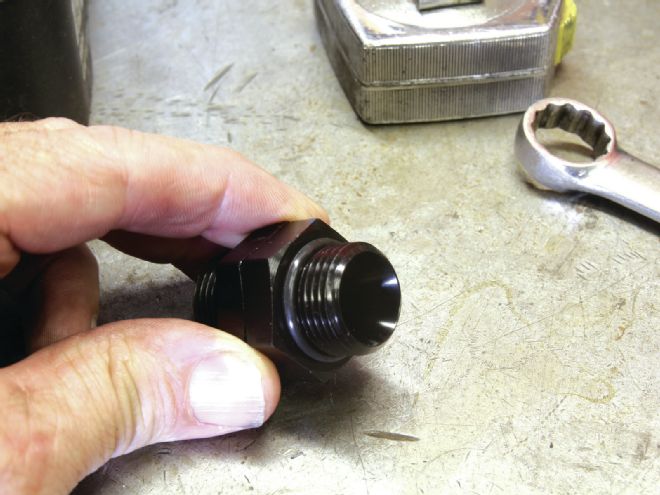
7. ORB fittings use straight (non-tapered) threads that employ O-ring seals. Unlike some fitting companies, Aeromotive supplies its ORB fittings with the O-rings installed. Aeromotive uses a proprietary nitrile rubber that is resistant to gasoline and alcohol fuels, as well as temperature variations that can adversely affect other materials.
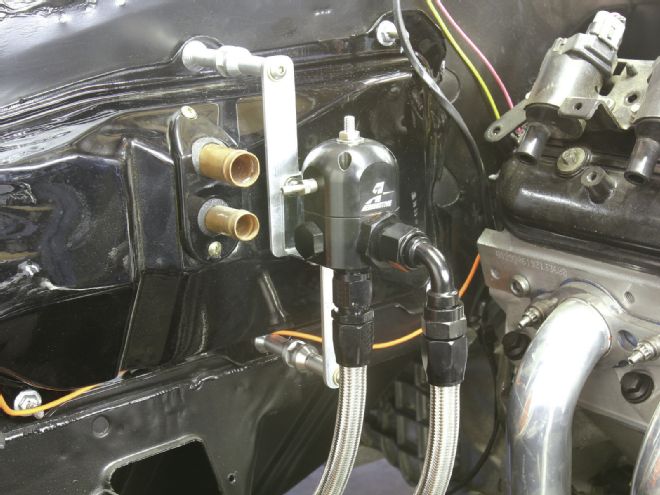
8. Moore built this custom aluminum mount that straddles the heater box and uses stock heater-box studs to position the Aeromotive low-pressure regulator. The inlet is an ORB-10 and an ORB -8 return with two -6 outlets along with a fuel-pressure gauge tap. All we have left to do here is complete the two -8 fuel lines to the fuel log.
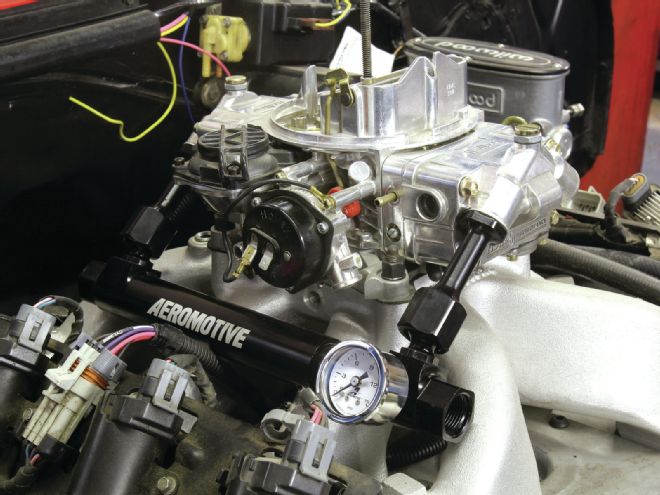
9. This is Aeromotive's trick carburetor fuel log. Internal O-rings allow the log to easily vary its length to accommodate different carburetors from 4160 to 4150 to Dominator-style carburetors.
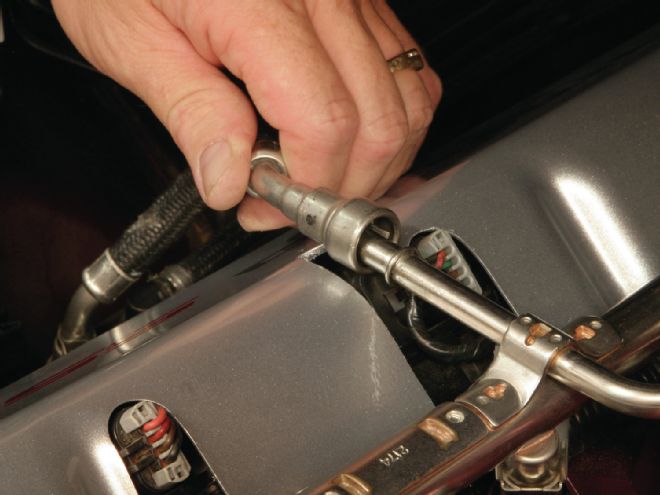
10. This Aeromotive drawing illustrates a typical carbureted installation. It's worth mentioning that, using the flow-through fuel log, the regulator can be installed on the back side of the log. This will work just as well as placing the regulator before the fuel log.

11. EFI fuel-delivery systems are only slightly different but operate at 43 to 60 psi pressures. In this configuration, the regulator balances pressure by returning unused fuel to the tank.
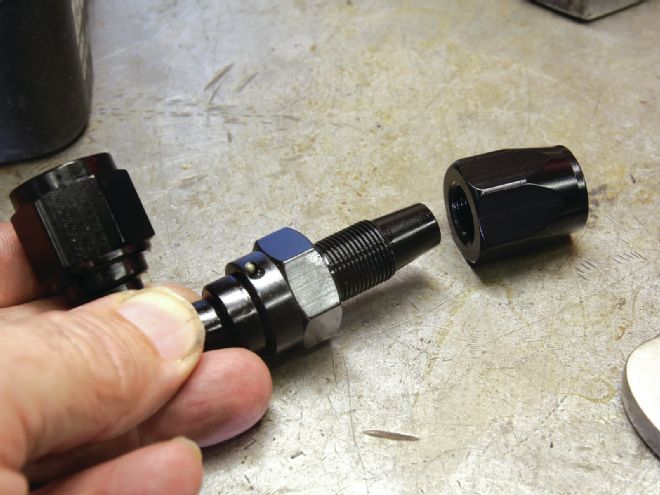
12. This is the Aeromotive fitting that is connected to the vent hose coming from the tank sending unit connection. The best way to install this vent is with a minimum 180-degree loop in the hose to prevent accidental siphoning from the tank through the vent hose.
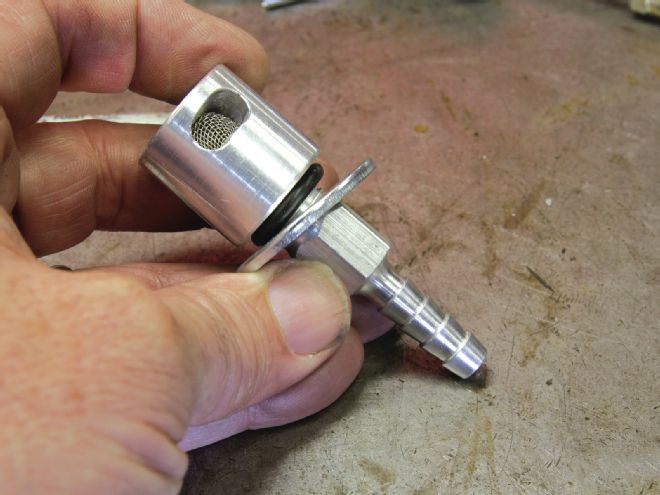
13. Aeromotive's fuel fittings use a tapered-style nipple to fit into AN hose. The taper does not cut into the hose, maintaining hose integrity.